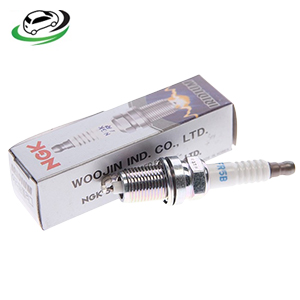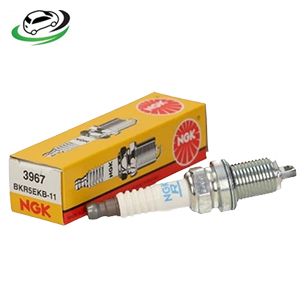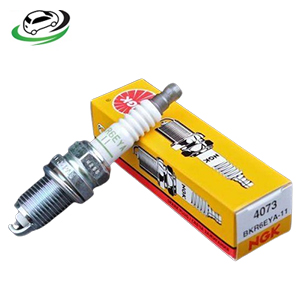-23%
Get NGK Spark Plugs Toyota, Lexus, Daihatsu BKR6EYA-11
Spark plugs are a critical component of the internal combustion engine, responsible for igniting the air-fuel mixture in the engine cylinders. They play a key role in engine performance, fuel efficiency, and emissions. Here’s a comprehensive overview of spark plugs, their types, and their functionality:
Function of Spark Plugs:
- Ignition:
- Spark plugs generate a spark to ignite the air-fuel mixture in the combustion chamber, initiating the combustion process.
- Heat Dissipation:
- They help to transfer the heat generated in the combustion chamber to the cooling system.
- Sealing:
- Spark plugs also act as a seal for the combustion chamber, preventing pressure leakage during the combustion process.
Types of Spark Plugs:
- Copper Spark Plugs:
- Electrode Material: Copper core with a nickel alloy coating.
- Benefits: Good conductivity and low cost.
- Drawbacks: Shorter lifespan (10,000 to 20,000 miles) due to rapid wear.
- Platinum Spark Plugs:
- Electrode Material: Platinum on the center electrode.
- Benefits: Longer lifespan (up to 60,000 miles) and better performance than copper.
- Drawbacks: More expensive than copper plugs.
- Double Platinum Spark Plugs:
- Electrode Material: Platinum on both the center and ground electrodes.
- Benefits: Enhanced durability and efficiency, suitable for wasted spark ignition systems.
- Drawbacks: Higher cost.
- Iridium Spark Plugs:
- Electrode Material: Iridium on the center electrode, sometimes with a platinum ground electrode.
- Benefits: Excellent performance, longest lifespan (up to 100,000 miles), and better fuel efficiency.
- Drawbacks: Most expensive type of spark plug.
- Silver Spark Plugs:
- Electrode Material: Silver center electrode.
- Benefits: Superior thermal conductivity.
- Drawbacks: Less common and typically used in older vehicles or motorcycles.
Benefits;
- Difficulty Starting the Engine: If your engine is slow to start, requires multiple attempts to start, or cranks for an extended period before starting, it could be a sign that your spark plugs are worn out or fouled.
- Rough Idling: A rough or uneven idle, where the engine vibrates excessively or feels unstable when the vehicle is stationary, can be a symptom of worn spark plugs. This roughness may also be accompanied by a noticeable decrease in engine smoothness.
- Poor Acceleration and Performance: Worn spark plugs can lead to sluggish acceleration, reduced engine power, and overall poor performance. You may notice that your car feels less responsive when you press the accelerator or struggles to maintain speed, especially when climbing hills or overtaking.
- Misfires and Hesitations: Engine misfires, characterized by brief interruptions in power delivery or hesitation during acceleration, are a common sign of faulty spark plugs. Misfires may manifest as jerking or sputtering sensations while driving.
- Decreased Fuel Efficiency: If you notice a sudden decrease in fuel efficiency, such as a drop in miles per gallon (MPG), it could indicate that your spark plugs are not igniting the air-fuel mixture efficiently. Inefficient combustion due to worn spark plugs can lead to increased fuel consumption.
- Increased Emissions: Worn or fouled spark plugs can result in incomplete combustion, leading to higher emissions of harmful pollutants such as hydrocarbons (HC), carbon monoxide (CO), and nitrogen oxides (NOx). A failed emissions test may indicate spark plug issues.
- Check Engine Light (CEL) Illumination: A lit check engine light on your dashboard could be triggered by various engine-related issues, including faulty spark plugs. The onboard diagnostic system may store trouble codes (e.g., P0300 for random/multiple cylinder misfire) that can help pinpoint the problem.
- Rough Engine Sound: A rough or irregular engine sound, often described as “knocking,” “pinging,” or “rattling,” can indicate spark plug issues. This noise may occur during acceleration or while the engine is under load.
- High Mileage or Age: If your vehicle has accumulated a high mileage or if it’s been several years since the last spark plug replacement, it’s advisable to inspect and replace the spark plugs as part of routine maintenance, even if you haven’t noticed any specific symptoms.
- Visible Signs of Wear or Damage: Removing and inspecting the spark plugs can provide valuable insights into their condition. Signs of wear, such as eroded electrodes, fouling, or excessive carbon buildup, indicate that the spark plugs are due for replacement.
Common Issues and Symptoms:
- Misfiring:
- Can be caused by worn or fouled spark plugs, leading to poor engine performance and increased emissions.
- Poor Fuel Economy:
- Worn spark plugs can cause incomplete combustion, reducing fuel efficiency.
- Hard Starting:
- Faulty spark plugs can make it difficult for the engine to start, especially in cold conditions.
- Rough Idle:
- Uneven combustion can lead to a rough or unstable idle.
Follow us on Facebook for more parts.



